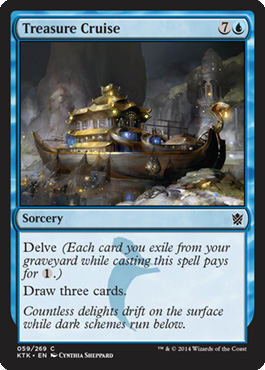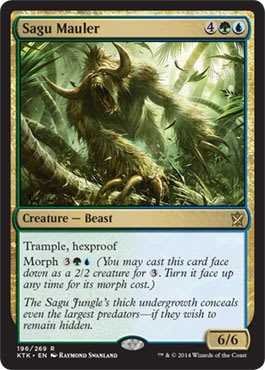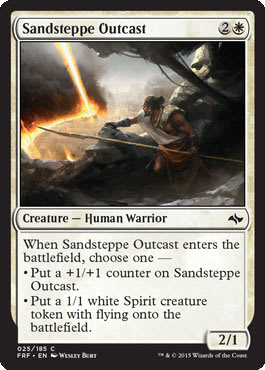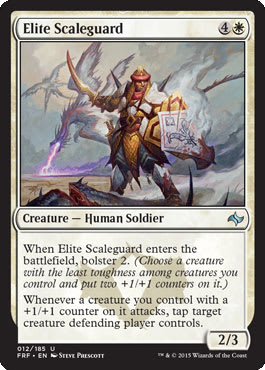This past weekend, all eyes were on Washington, D.C., as the pros battled it out in uncharted Modern territory. Which decks would flourish in Birthing Pod’s absence? How similar would the format look to Modern prior to Khans of Tarkir, before efficient card-draw spells with delve took over?
As I mentioned last week, I care a lot about the Modern format, but I’ll be honest—I woke up at 6:00 A.M. on Friday just to watch the Draft and went about my daily routine once Round 3 was over. I make no secret of the fact that Khans of Tarkir is among my favorite Draft formats, and I wanted to watch it evolve. The commons are strong, the clans are well-balanced, and the Morph mechanic makes for some interactive and challenging games. No format I’ve drafted before has made it so easy to represent multiple tricks and so difficult to make profitable blocks. Most of all, however, I love drafting multicolored sets because having to prioritize fixing adds another layer of complexity to the Draft itself. In a lot of ways, drafting Khans of Tarkir feels like drafting a low-power Cube. So, there I was, glued to my TV set, watching Josh Utter-Leyton and Luis Scott-Vargas draft and soaking up as much knowledge as I could about Fate Reforged.
Luckily, I had a handful of opportunities to draft the format for myself the previous week, so I did have a few preconceived notions as I watched the broadcast. I drafted Fate Reforged for the first time with my local Lady Planeswalkers Society chapter last Tuesday, and I admit I had no idea what to expect. In Khans of Tarkir Draft, I mostly went with the flow, finding my way into the clans that were most open (which, in many cases, were Temur and Sultai). I took morphs and fixing highly in Khans; Fate Reforged had no morphs and few gold cards, and it only provided one nonbasic land per pack. I’d have to develop a new plan for this Draft.
I opened my pack of Fate Reforged and found a Shaman of the Great Hunt in the rare slot. Well, that was easy, I thought as I put the card face down in front of me. The Shaman had a reasonable body, could generate card advantage, and didn’t commit me to a color group. I could still activate its ability if I ended up playing Jeskai, and at worst, I could play an aggressive B/R or R/W deck and use it to buff my creatures. It was a fairly easy first pick.
The next pack I looked at was fairly weak, and none of the cards complemented the Shaman; I took a Mardu Shadowspear with some reservations, trying to stay open. Then, in the third, a foil Yasova Dragonclaw appeared. She and the Shaman seemed like they would be fast friends, so I eagerly snatched her up and added her to my pile. Next, I chose Ethereal Ambush, a card I hadn’t played with in the prerelease but that seemed to be a strong combat trick. I received another gift fifth pick in the form of Mob Rule, a potentially game-ending spell. Within a few minutes, I had the beginnings of a strong R/G deck—I’d found Hunt the Weak, Destructor Dragon, and two Goblin Heelcutters. Maybe I’d even splash blue for Ethereal Ambush, if possible.
I fleshed out a creature-heavy R/G deck throughout pack two, never wavering, until pack three, pick two, when my neighbor to the right passed me a Sagu Mauler. Sagu Mauler was one of the biggest bombs from Khans of Tarkir, and I had no doubt that it would continue to dominate in Fate Reforged Draft, where 1- and 2-toughness creatures are plentiful. Fortunately, I was able to pick up three pieces of blue fixing throughout the pack, making my blue splash reasonable. Here’s my final list:
R/G Sagu ? Fate Reforged Draft | Hallie Santo
- Creatures (16)
- 1 Alpine Grizzly
- 1 Destructor Dragon
- 1 Highland Game
- 1 Hooting Mandrills
- 1 Leaping Master
- 1 Sagu Mauler
- 1 Shaman of the Great Hunt
- 1 War-Name Aspirant
- 1 Woolly Loxodon
- 2 Bloodfire Expert
- 2 Goblin Heelcutter
- 2 Summit Prowler
- 1 Yasova Dragonclaw
- Spells (6)
- 1 Crippling Chill
- 1 Ethereal Ambush
- 1 Barrage of Boulders
- 1 Hunt the Weak
- 1 Mob Rule
- 1 Savage Punch
- Lands (18)
- 1 Island
- 6 Forest
- 7 Mountain
- 1 Frontier Bivouac
- 1 Rugged Highlands
- 1 Swiftwater Cliffs
- 1 Thornwood Falls
I had never built a deck around the ferocious mechanic before, but this one seemed fairly strong. The deck had several win conditions, and the six games I won all played out differently, keeping my opponents and me on our toes. Sagu Mauler made a few appearances and won a game all on its own. I stole opposing creatures with Yasova and Mob Rule and forced damage through with Goblin Heelcutters. (I once won a game by casting both for their dash cost on the same turn.) Not all my games ended in big blowouts, however—my deck had a solid creature base and good mana, so it was easy for me to curve out and pull ahead in the early game to set up an eventual victory.
I’ve come to realize, both from watching Pro Tour Fate Reforged coverage and from drafting the set for myself, that playing two colors is often the way to go. Guaranteed nonbasic lands notwithstanding, fixing is much harder to come by in Fate Reforged, so I try to play as few colors as possible in my Draft decks. This set has also made me change my color preferences: in Khans Draft, I’d often settle on an enemy-color pair early in an effort to be open to two clans, but now I seem to end up in ally colors much more often. At my Draft last Tuesday, I received some strong signals that red and green were open, and the deck I drafted was mostly made up of mono-colored cards; I took a minor risk when I chose Ethereal Ambush fourth in pack one, but I didn’t commit to splashing a third color until much later in the Draft. LSV employs a similar strategy during his Day 1 Draft at the Pro Tour: He speculates on a few picks, but he sticks to white and blue for most of the Draft, only committing to red after picking up a Jeskai Ascendancy in Pack 3.
Splashing a third color for a powerful card seems reasonable in this new Draft format, which is considerably more bomb-driven than the previous one. Unlike Khans of Tarkir, where powerful morph creatures could be found at common and uncommon, Fate Reforged is much more top-heavy; many Drafts start out as my first one did, as the majority of rares and mythics are leagues above the commons and uncommons. So far, I’ve chosen the card in the rare slot in all but one Fate Reforged Draft; Elite Scaleguard was easily the pick over Scroll of the Masters.
Of course, Fate Reforged does have its fair share of powerful commons and uncommons. Before we wrap up today, I’d like to share some of the cards at lower rarities that have impressed me the most.
Commons
Sandsteppe Outcast — I enjoy the cycle of modal commons, but Sandsteppe Outcast is probably my favorite. Two-for-ones are always important in Limited, and this creature brings a buddy with wings. This Outcast plays pretty nicely with outlast, too, and it even has the Warrior subtype. What more could you want?
Aven Surveyor — Speaking of modal spells, here’s another one that’s high on my list. The double-blue casting cost can be prohibitive at times, but so far, I haven’t regretted running Aven Surveyor. Bounce effects are always strong in Limited; you can even return one of your own creatures to your hand to remove a pesky Aura, if necessary. Plus, a 3-power flyer isn’t half-bad either.
Goblin Heelcutter — While the bombs in my first Draft deck helped close out a lot of games, Goblin Heelcutter did most of the heavy lifting. This efficiently-costed creature is a must-have in a red aggressive deck, and its dash ability helps it maneuver around Debilitating Injury. Heelcutter certainly isn’t immune to Douse in Gloom and other cheap removal, but in the right board state, it can have devastating effects.
Uncommons
Elite Scaleguard — Elite Scaleguard is the most first-pickable uncommon in the set, Scroll of the Masters notwithstanding. Don’t let the high casting cost fool you: On an empty board, this is still a 4/5 that taps a potential blocker. If you want your first-pick Scaleguard to reach his full potential, fill your deck with effects that put counters on things. My Magic Online deck featured such hits as Incremental Growth, Abzan Ascendancy, and Abzan Charm, but Hunt the Weak and some outlast creatures are often enough to do the trick.
Merciless Executioner — This card came in handy at a Sealed PPTQ that I played in over the weekend. In a format in which players frequently tap out to play huge Dragons, a Fleshbag Marauder does a ton of work. My favorite play from the weekend involved disposing of my opponent’s 2/2 Vampire token, leaving his Silumgar, the Drifting Death alone on the battlefield to be executed. Executioner provides the most value in a W/B shell—it’s a Warrior, and odds are you can upgrade a 1/1 token into a 3/1 attacker while your opponent sacrifices a huge threat—but it’s a useful tool for any black deck.
The Dragon Cycle — I’ve seen a lot of uncommon 4/4 Dragons flying around, and they range from excellent (Destructor Dragon blows up your opponent’s only black source, preventing him or her from casting any more removal spells; Noxious Dragon destroys the 5/5 Spirit Warrior token that your opponent made after curving Archers' Parapet into Kin-Tree Invocation) to actively bad (your opponent was mana-screwed until you attacked with a Mindscour Dragon, and now he or she can cast Treasure Cruise and get back in the game). On the whole, these Dragons are fine inclusions in any Draft deck, though they’d probably prefer that you play two colors.
Want to practice drafting Fate Reforged? Check out Wizards of the Coast’s Pro Tour Fate Reforged Draft Viewer—choose cards from an actual pack that was opened at the Pro Tour—then see what the pros picked! Once you get the hang of it, try a Fate Reforged Draft at your local store or on Magic Online; release events are still going on through February 18. Happy drafting!
























